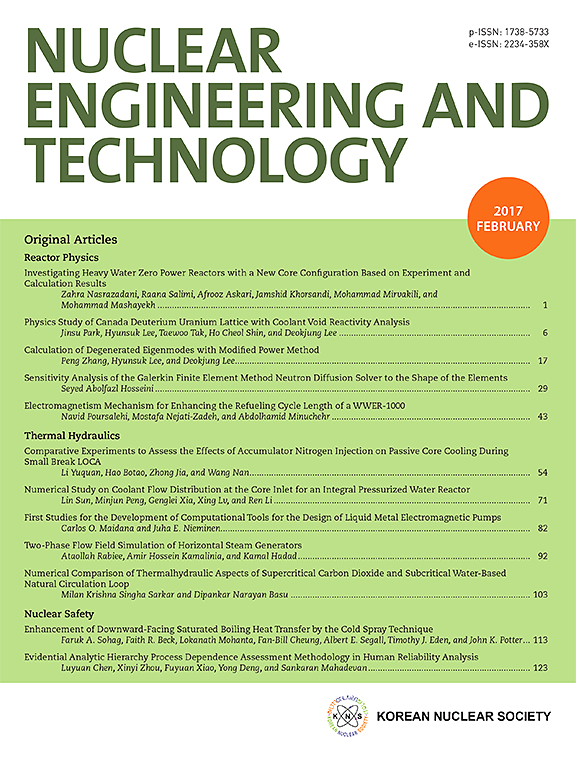Research on superheated steam discharge: Leakage process with friction and jet impingement process
IF 2.6
3区 工程技术
Q1 NUCLEAR SCIENCE & TECHNOLOGY
引用次数: 0
Abstract
The leakage and jet impact characteristics of steam play a crucial role in the safety analysis of nuclear power plant accidents. The prediction model of leakage flow is crucial for Leak-before-break (LBB) analysis. Simultaneously, the study of jet impact process is fundamental for preventing damage to surrounding system equipment. In this paper, two cross-sectional shapes passages are utilized: circular with diameters of 6∼8 mm and elliptical with dimensions of 8∗5.26 mm, featuring length-to-diameter ratios of 5.2–105. The study focuses on superheated steam ranging from 4.6 to 7.5 MPa, measuring leakage rates under various inlet and passage conditions, pressure drops along the passage, and the impact force exerted by the jetted superheated steam on a 400 mm square plate. In experiments, it was found that the pressure drop trend in the flow passage of steam is crucial for predicting the leakage flow rate. The isentropic model was revised based on experimental data, resulting in a model that better fits the experimental results than the original isentropic model and a simpler form compared to Yang's one-dimensional friction model. The study also revealed that the length-to-diameter ratio and related friction effect significantly affect the leakage flow rate and steam jet impingement process. The variation pattern of impingement force coefficient was summarized based on experimental data. Due to the visualization of the experiment, some special phenomena during the experimental process were also recorded.
过热蒸汽排放的研究:摩擦泄漏过程和射流冲击过程
蒸汽的泄漏和射流冲击特性在核电厂事故安全分析中起着至关重要的作用。泄漏流量预测模型是泄漏前破漏分析的关键。同时,射流冲击过程的研究是防止周围系统设备损坏的基础。在本文中,使用了两种截面形状的通道:直径为6 ~ 8 mm的圆形通道和尺寸为8 * 5.26 mm的椭圆形通道,其长径比为5.2-105。以4.6 ~ 7.5 MPa的过热蒸汽为研究对象,测量了不同进口和通道条件下的泄漏率、通道压降以及喷射过热蒸汽对400mm方形板的冲击力。实验发现,蒸汽流道内的压降趋势是预测泄漏流量的关键。在实验数据的基础上对等熵模型进行了修正,得到的模型比原来的等熵模型更符合实验结果,比杨的一维摩擦模型形式更简单。研究还发现,长径比及其摩擦效应显著影响泄漏流量和蒸汽射流撞击过程。根据实验数据,总结了撞击力系数的变化规律。由于实验的可视化,还记录了实验过程中的一些特殊现象。
本文章由计算机程序翻译,如有差异,请以英文原文为准。
求助全文
约1分钟内获得全文
求助全文
来源期刊

Nuclear Engineering and Technology
工程技术-核科学技术
CiteScore
4.80
自引率
7.40%
发文量
431
审稿时长
3.5 months
期刊介绍:
Nuclear Engineering and Technology (NET), an international journal of the Korean Nuclear Society (KNS), publishes peer-reviewed papers on original research, ideas and developments in all areas of the field of nuclear science and technology. NET bimonthly publishes original articles, reviews, and technical notes. The journal is listed in the Science Citation Index Expanded (SCIE) of Thomson Reuters.
NET covers all fields for peaceful utilization of nuclear energy and radiation as follows:
1) Reactor Physics
2) Thermal Hydraulics
3) Nuclear Safety
4) Nuclear I&C
5) Nuclear Physics, Fusion, and Laser Technology
6) Nuclear Fuel Cycle and Radioactive Waste Management
7) Nuclear Fuel and Reactor Materials
8) Radiation Application
9) Radiation Protection
10) Nuclear Structural Analysis and Plant Management & Maintenance
11) Nuclear Policy, Economics, and Human Resource Development
 求助内容:
求助内容: 应助结果提醒方式:
应助结果提醒方式:


